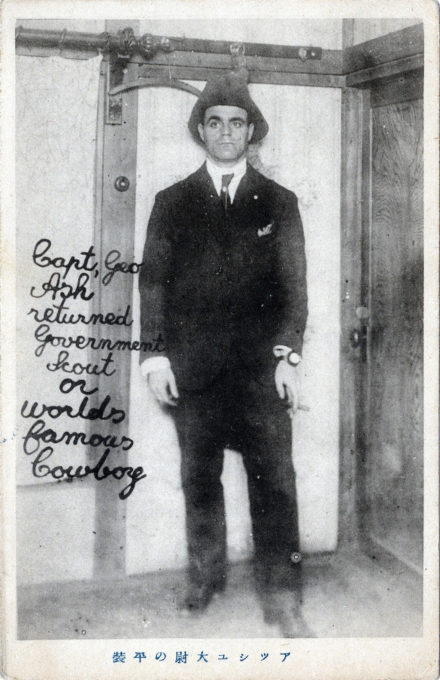“On February 6, 1918, the theater Yūrakuza, built with one of the first Western influenced architectural designs, announced the show ‘Cowboys and Girls’ Opera’ that ran for seven days. Yūrakuza was famous for featuring new styles of theaters influenced by the West, called Shingeki, compared to Kabuki and other traditional theaters.
“In this figuratively and symbolically modern theater, Captain George Ash on Cowboy Acts performed rope spinning, gun spinning and rope throwing followed by a comedy opera by female singers … Captain Ash wore cowboy hats, fur chaps around his trousers, a jacket with studs and embroidery and he had a rope in his hand.
“Asahi shimbun later reported Sakamoto, the prominent professional storyteller who explained the stage acts and show’s stories, made so many jokes about cows by using the words that described beef. Asahi told about Captain George Ash, not as a male model that Japanese men could emulate, but in a way to describe him as a target of laughter, not as an admirable figure.”
– Tokyo Rodeo: Transnational Country Music and the Crisis of Japanese Masculinities, by Mari Nagatomi, 2018

“Capt. Geo. Ash, returned Government Scout or World’s Famous Cowboy”, Tokyo, c. 1920. Born in Alberta, Canada, Ash would migrate to the U.S., become a cowboy and, later, a Texas Ranger. Captured by Francisco “Pancho” Villa, Ash would escape after eighteen months of captivity. Ash joined the U.S. Army cavalry during World War I and served in Europe, earning his rank of captain. Enraptured by stories he heard from fellow soldiers of “far-off exotic lands”, Ash began touring the world after the war as a cowboy and lariat expert.
See also:
Aviator Art Smith racing a “Baby Car” while on tour in Japan, ca. 1916.
Aviatrix Katherine Stinson in Japan, c. 1916.
“It was in the spring of 1919 that I was first asked by the military authorities to give cowboy exhibitions to the native troops in India … How the War Office came to engage me is an interesting story.
“On the morning of Saturday, April 12th, I was walking along Strand Road, one of Calcutta’s principal thoroughfares, when I saw a huge crowd of natives shouting, yelling, and brandishing fire-arms and sticks. As I got nearer, I saw they had surrounded a wagon coming from the Mint – loaded, as I afterwards discovered, with silver. The driver and escort were in a bad way, for as there seemed to be no police or soldiers about they were at the mercy of the mob.
“I had my revolver with me, and pushing my way through the excited crowd, I jumped on to the wagon, getting a good many hard blows from cudgels as I did so. Once on the vehicle I drew my revolver and levelled it at the crowd. They made a rush in my direction, but pulled up when they saw I meant business. Then I made my way to the back of the wagon, telling the driver to get back to the Mint as quickly as he could.
“As soon as the mob saw they were going to be outwitted they rushed forward once more. This time I fired … Three fellows went down with the three shots I fired and this scared the rioters … A few minutes more and the wagon was safely back in the Mint.
“When I discovered that I had saved a cargo of silver, I certainly expected the Government would acknowledge my services in some practical way, but all I received was a bare ‘Thank you!’
“The military authorities, however, congratulated me most enthusiastically, and suggested I should stay in India and give lassoing, shooting, and riding exhibitions to the troops.
“I had only just come from Japan, China, and the Malay States, where I had been giving cowboy shows, and I suppose my reputation with the rope and revolver preceded me. Anyhow, I accepted the offer have been virtually in [colonial] Government employ ever since.
“What is more, I have not only been called upon to give displays, but to actually instruct troops in the use of the lasso.”
– “Round the World with a Lasso”, by Captain George Ash, The Wide World Magazine, September 1923

